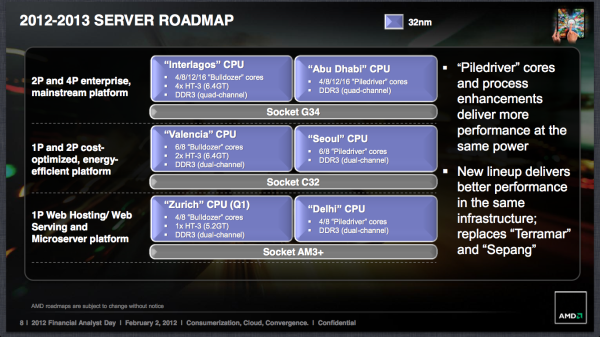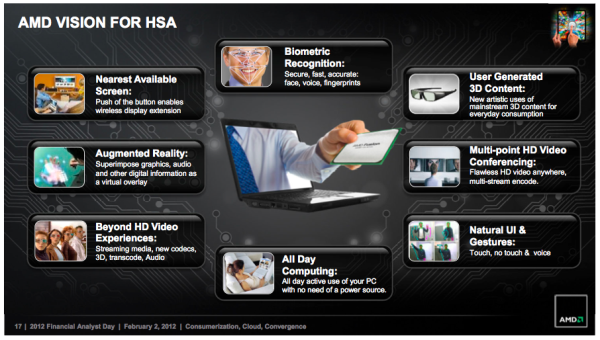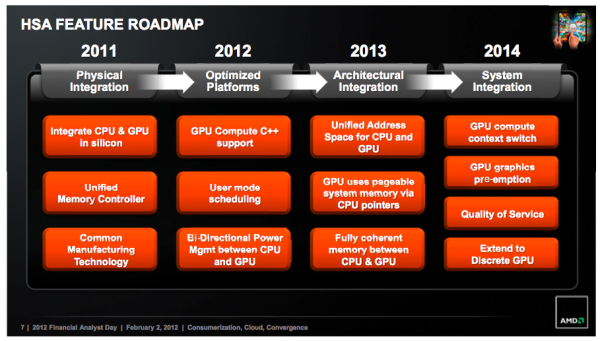Understanding AMD's Roadmap & New Direction
by Anand Lal Shimpi on February 2, 2012 6:16 PM EST- Posted in
- CPUs
- AMD
- Trade Shows
- AMD FAD 2012
The New Focus: Client Mobility
For years we had asked for lower power AMD mobile solutions. While we finally started seeing some progress over the past couple of years, AMD is now very committed to building mobile devices. Anything tablet sized or above is now AMD's target for client APUs.
AMD was always the high-end x86 CPU alternative to Intel in the PC space, now AMD is going to be the alternative in the ultra mobile space.
Servers & the High End Desktop
AMD's server roadmap for the next two years is a bit more conservative. We'll see Piledriver updates from top to bottom but there's no significant departure from the way things are done today. There are no plans for any new sockets in the near term, just using existing platforms to grow AMD's server marketshare without huge new investments.
As AMD's client strategy is predominantly built around APUs, the only high-end desktop parts we'll see from AMD are low-end server CPUs. Socket-AM3+ has a future for one more generation and we'll likely see other single-socket, high-end platforms for the desktop. The days of AMD chasing Intel for the high-end desktop market are done though. That war is officially over.
The Ace: HSA
AMD isn't going to have the fastest general purpose x86 CPUs on the market and it is no longer interested in pursuing that goal. It does promise to have much better on-die GPU performance than Intel. For users today that's primarily an advantage in 3D gaming. As more workloads shift to the GPU however, AMD could have a significant advantage here. The problem is that seamlessly scheduling client workloads across CPUs and GPUs just hasn't happened, the two islands of compute horsepower have remained discrete - even on the new wave of integrated APUs.
AMD's Heterogenous Systems Architecture (HSA) plans to change that. AMD wants to see the creation of a virtual ISA that will be the backbone of a software layer that can schedule application workloads on any combination of underlying CPU/GPU hardware, regardless of the ISA of the hardware. If you have a workload that's best run on big, general purpose x86 cores, that's where it will run. If a task is better designed for highly parallel GPUs cores, it'll run there. And presumably if you had an ARM core somewhere underneath and the workload would run better on it, you'd be covered as well.
AMD plans on delivering an HSA enabled GPU family by 2014, with today's Graphics Core Next GPUs being an intermediary step that already fill a number of these goals. These HSA GPUs would be able to share the same memory space as CPUs and work seamlessly as coprocessors. Granted AMD doesn't have the best track record of quickly moving the industry with things like HSA (although AMD64 did work out quite well), so we'll have to wait and see how all of this plays out.
If AMD can get broad industry support for HSA then its APUs become much more attractive. The overall performance of AMD solutions would then become more compelling as they'd take both CPU and GPU architectures into account, again assuming the workloads require both.













84 Comments
View All Comments
arjuna1 - Friday, February 3, 2012 - link
Yeah yeah, the butt hurt one reporting, you can't understand because you weren't into brand loyalty, I did have an "arbitrary affinity" for AMD products, heck, I still do, but I certainly did get into building systems recently.I'm glad you want an APU in your next desktop build, I do not, if I did I would be looking to purchase a laptop or any other mobile device.
I want to empathize again, I get it that it's healthy for AMD to focus on where the money is, but doing so at the expense of they desktop offerings is forgetting about those of us who helped build and sustained AMD phenom II point.
There is no other projected desktop CPU other than Vishera, and that on itself is a low end server part being sold as a high end part, the 3rd generation BD will go to Kaveri, which is an APU.
If that does not sound like forfeiting the game, I don't what does, even Anand acknowledges AMD is out of the high end desktop CPU race.
B-Unit1701 - Friday, February 3, 2012 - link
AMD is not 'forgetting' those who got them here, they are finnaly ending their torture. For years we've been waiting with huge erections for the unveiling of AMDs newest, and then get let down with sad, sad performance. They are ending the cycle of pain and going towards what they do well instead. I say good deal, make some money and improve.mhahnheuser - Friday, February 3, 2012 - link
What is missed in all this discussion is that Llano is a far far better purchase out of the box than Sandybridge, not just better, AMD first daylight second and Intel some distance back in the dust. It's only when you add a third party GPU that SB even gets in the picture.Why would AMD want to put all this effort and expense chasing ultra low volume, outright single core IPC performance and get peanuts for it when it can get uber-prices for stand alone GPU's of which they are currently pulling around 50% of the Intel platform. It's the GPU which provides the uber performance not the CPU, and a 7970, 50 0r 90 will make more than double the money for AMD than a Bulldozer CPU that can manage to outperform a SB-E by 10 FPS with the same high end GPU.
They're (AMD) in a pretty good space to persue more lucrative market segments.
frozentundra123456 - Saturday, February 4, 2012 - link
I see no reason at all to purchase llano on the desktop. Just get an Intel CPU for better performance and add a discrete 50.00 card if you want good graphics. If I were buying a laptop I would probably get llano, but on the desktop it is mediocre at everything, and a discrete card is a much better solution.seapeople - Saturday, February 4, 2012 - link
That's the same thing as saying a 10-speed bicycle is a far far better purchase out of the box than a Porsche 911. It's only until you add a third party combustible hydrocarbon that the Porsche 911 becomes a better means of transport.mhahnheuser - Friday, February 3, 2012 - link
...and just for good measure, with Intel chasing the gamer enthusiast market is actually doing AMD's work for them in driving aplications toward increased GPU performance, which long term has got to be in AMD's interest, given their future plans for more GPU utilisation, so theirs is not a dumb strategy to let Intel do most the heavy lifting in the enthusiast segment.dicobalt - Saturday, February 4, 2012 - link
Intel will be rolling out 14nm in 2014. AMD really needs to get Globalfoundries to speed up. It's really disappointing to hear AMD isn't interested in competing on process. I can't see AMD as being able to compete.rocketbuddha - Saturday, February 4, 2012 - link
Worse is that AMD has no advantages other than being fabless.a) Its die-size at similar nodes is bigger than competition
b) Reduces yields.
c) No longer a tight coupling with the foundries. Going forward I see GF not neccessarily accomodating AMD's concerns on Node race.
While I am disappointed I think Rory Read made the right decision with the cards he has been dealt with. AMD should be extra smart....
tipoo - Monday, February 6, 2012 - link
I don't think AMD has that kind of pull at GloFo anymore. They got rid of most of the controlling share, if I recall.Rictorhell - Saturday, February 4, 2012 - link
Wow. I've been a computer fan for years now and suddenly, people care more about cellphones and smartphones then they do about actual computers. When did that happen? How is it that the internet has been popular for years now, but yet, very little has actually changed? The technology still feels slow to me, in many ways.We have Facebook and Twitter and Youtube, yeah, but are these really exciting and amazing advancements in technology? I've read and heard reports that there just aren't many people taking up computer science and computer programming and from what I have seen, I can kind of believe those reports.
Unless, the majority of people that are really interested in working in the computer field are focusing mainly on videogames or IT.
I don't really have anything against smartphones, except the fact that to really get a good amount of use and enjoymment out of them, you have to sign a contract with Verizon or some other service provider. I love PDAs and I still use one, I just wish there was an interest in developing modern PDAs that did not require monthly payments or contracts.
I like the idea of things like the Ipod Touch and the Samsung Galaxy Player, but both of those pieces of hardware are basically inferior to their smartphone counterparts, created by the same companies.
What if I want a device with the same quality of screen as the Iphone 4 or the Samsung Galaxy Nexus, but I just don't want to sign a contract? If I am willing to pay for a quality gadget, I would hope that someone out there would be willing to build it, but that doesn't seem to be the case.
I kind of see tablets as a bigger and better version of PDA, but I need something with a decent amount of storage space and processing power.
The upcoming WIndows 8 tablets might be just what I am waiting for, but I am hoping for some actual innovation and creativity and not just a more mobile version of what I already have.